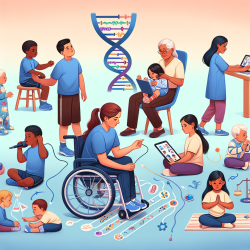Introduction to PPP2R5D-Related Disorders
In the realm of speech-language pathology, understanding the genetic and biochemical bases of disorders is crucial for tailoring effective interventions. One such disorder, PPP2R5D-related intellectual disability and neurodevelopmental delay, presents unique challenges and opportunities for practitioners. This blog aims to unpack the findings from the research article "PPP2R5D-Related Intellectual Disability and Neurodevelopmental Delay: A Review of the Current Understanding of the Genetics and Biochemical Basis of the Disorder" and explore how these insights can be leveraged in practice.
The Genetic Underpinnings
PPP2R5D-related disorders are primarily caused by de novo mutations in the PPP2R5D gene. This gene encodes a regulatory subunit of the enzyme protein phosphatase 2A (PP2A), which is vital for various cellular processes, including those in the brain. Mutations in this gene are linked to a spectrum of clinical manifestations, such as intellectual disability (ID), autism spectrum disorder (ASD), epilepsy, and speech problems.
Clinical Implications
For practitioners, understanding the genetic basis of these disorders is essential for accurate diagnosis and intervention planning. The clinical signs often overlap with other neurodevelopmental disorders, necessitating comprehensive genetic testing alongside traditional diagnostic methods. This approach ensures a more precise diagnosis, enabling targeted therapeutic interventions.
Data-Driven Interventions
Given the complexity of PPP2R5D-related disorders, data-driven approaches are paramount. Practitioners should consider integrating whole-exome sequencing (WES) into their diagnostic toolkit to identify pathogenic variants of PPP2R5D. This genetic insight can inform the development of personalized therapy plans that address the specific needs of each child.
Encouraging Further Research
The current understanding of PPP2R5D-related disorders highlights the need for continued research. Practitioners are encouraged to stay abreast of emerging studies and consider participating in research initiatives. Collaboration with geneticists and other specialists can enhance the understanding of these disorders and contribute to the development of innovative therapeutic strategies.
Conclusion
While there is no cure for PPP2R5D-related intellectual disability, the management of symptoms and targeted interventions can significantly improve outcomes for affected children. As practitioners, leveraging genetic insights and adopting a data-driven approach will enhance the effectiveness of therapy and support the holistic development of children with these disorders.
To read the original research paper, please follow this link: PPP2R5D-Related Intellectual Disability and Neurodevelopmental Delay: A Review of the Current Understanding of the Genetics and Biochemical Basis of the Disorder.










